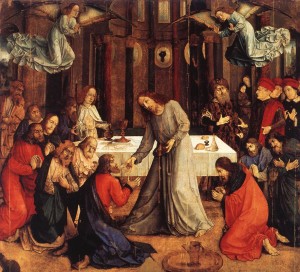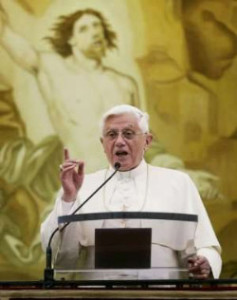[adapted from the notes for Solemn Vespers, 3/24/17 at the Monastery]
The meeting of time and eternity, of the finite and the infinite, of the human and the divine. Today’s solemnity is a perfect crystallization of the reconciliation willed by God and accomplished through Mary’s fiat (“Amen” in her native Aramaic), as well as of the destiny that the Holy Trinity has allotted humanity. As we say in tonight’s concluding prayer, “may [we] merit to become partakers even of His divine nature,” Who willed to unite Himself to our human nature.
![]() The Annunciation is one of the most popular scenes in Western art and Eastern iconography. The Virgin Mary holds in her hand a spindle and scarlet material used to make the veil of the Temple. This veil is what separates the divine from the human, but also, being a central item in the Temple represents the meeting of God and Israel. We should recall that Herod began rebuilding the Temple at about the time of the Virgin Mary’s birth (there are many references to its construction in the New Testament). She will give birth to the true and everlasting Temple, the Body of Christ.
The Annunciation is one of the most popular scenes in Western art and Eastern iconography. The Virgin Mary holds in her hand a spindle and scarlet material used to make the veil of the Temple. This veil is what separates the divine from the human, but also, being a central item in the Temple represents the meeting of God and Israel. We should recall that Herod began rebuilding the Temple at about the time of the Virgin Mary’s birth (there are many references to its construction in the New Testament). She will give birth to the true and everlasting Temple, the Body of Christ.
There is good reason to suppose that the solemnity of the Annunciation predates the celebration of Christmas, a noteworthy reminder that Christians have traditionally held that life begins at conception and that childbirth is the public manifestation and arrival of a child already long-nurtured by his or her mother. Many liturgical scholars, perhaps the majority at this point, fix the date of the Annunciation by the traditional date of Good Friday, since Christ was believed to have become man and to have died on the same date. From today’s date was then calculated the date of Christmas, nine months from March 25.
Our Lady’s gracious “yes” to the divine invitation to participate in the salvation of the world is a model of faith for all believers. Every time we obediently say, “yes,” to life, to suffering, to the commandments, Christ’s life is strengthened in us, and His healing presence is manifested to the world. Through our perseverance, we will save our lives by bringing to birth the life of Christ conceived in us at our first “yes” at baptism.
In tonight’s Processional chant, another ancient teaching is celebrated, the naming of Mary as the destroyer of all heresies. The key to understanding right belief is the Incarnation itself (the Trinitarian doctrines distinctive of Christianity are consequences of reflection on the virgin birth by the overshadowing of the Holy Spirit). One could rightly read the first seven Ecumenical Councils as continued explorations of the mystery revealed in the encounter of Our Lady with the Archangel Gabriel, and the resulting unity of God and man. If ever we are troubled by doubts about the doctrine of the Church, the Mother of God is always waiting to illuminate us. She is a sure protector in times of temptation. She who listened to the voice of Gabriel undid the sin of Eve who listened to the voice of the tempter. Thus is Our Lady a model of discretion.
So many of these images come together in the final antiphon, Ave Regina Caelorum, traditionally sung from the Feast of the Presentation (formerly of the Purification) until the Paschal Triduum. “Hail root of Jesse! Hail gate of heaven!” In the Annunciation is fulfilled so many prophecies of the Old Testament foreseeing the coming of the Messiah and the reopening of Paradise. As God entered the world through the gate of Mary’s womb, we enter the divine life through the womb of the font of baptism. And so each evening, as we prepare for the dark hours, filled with many temptations, we call on the assistance of the great Mother of God and recall our baptisms by the sprinkling of holy water.
May this wondrous celebration fortify us in our Lenten practices of self-denial, and may it remind us of the glory that God has promised to those faithful to the teachings and practices of Holy Mother Church, in whom is fulfilled what was begun in the life of our Holy Mother, the Virgin Mary.
















![Christ's Ascension is the founding movement of every liturgical celebration. Now He intercedes for us at the right hand of the Father [Romans 8: 34].](https://chicagomonk.org/wp-content/uploads/2015/07/ascension-coptic-215x300.jpg)
